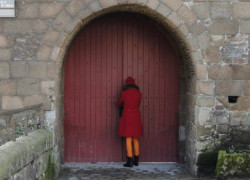
Words by Brianna Bullen
I sit alone at a desk. I’m at a library at the end of a long line of restaurants in Docklands, overlooking the water. I can see through a strip of glass outside to construction sites, half-finished but dense, as the book seems to be at times. Ripe for transformation. The book and a clock (minimalistic with two metal hands) are the room’s only features, beside a grey-lead we are offered to use on the pages. Collaborative live art. I see messages left by those before me and debate leaving my own. The book is rich and handcrafted, a patchwork assortment made to seem scrapped together by a master craftsman, sealed with a nail, steampunk clasp and leather strap. Alone with the book in this bureaucratic cubicle which feels more like a dreary office than part of a library, time seems to stand still. Yet it’s felt with a greater urgency. ‘Paradox matters’ someone has contributed. Thirty minutes to read the end of the world. The silence is claustrophobic.
It’s a three-dimensional experience: I must manoeuvre the pages, read some upside down (written in wax, looks like invisible ink) to unlock all the story strands. Some of it’s in code; I follow the key to crack it. ‘Father death today.’ I pause. Three little symbols—triangles, a dark square, and lines—convey a story hidden to those who do not pause to decipher it among the hail of words. It’s unexpected. Textured hidden messages. Most symbols repeat over pages, mimicking repeated days—‘together meeting sunrise.’ One strand among many—‘all books discussed are component parts’—follows the mysterious Olena, another logs council meeting attendance. An abstract signified cat meows on the page. A man, chased by something, stops writing suddenly, pencil ominously pulled down the page mid-letter. All are preoccupied with words and the fall of the world: the loss of stories, attempts to control the world’s history in a single tale that falls away in multiple voices. Meditations on writing are scrawled in fountain pen, faecal-and-dirt brown paint, and pencil. The stories work most effectively when the personalised comes through; the predominant tale itself is ambiguous, heavily relying on genre trappings to make the fall seem universal. The odd images and tales that keep me reading.
Half an hour alone, in the quiet, with a book is a luxury: the silence and tension on the page becomes embodied in the struggle to get through it in the allocated time. It is a little unpleasant and unsettling. Someone’s comment on dreaming in tweets breaks through the piece’s low-tech aura, placing the tale in time. ‘How can you sit and write when the world is dying?’ The pertinent question. Creator Georgia Symons poses one answer, her readers even more. Ultimately, the piece functions as a record of the anxiety of a time where books have simultaneously lost their value and mean everything. Whether the installation succeeds in its objective—perhaps hampered by its ambiguity—is difficult to answer, but the multitude of comments scrawled by others suggest it has left an impact.

